
|
Johannes Juul, 1887 - 1969
Danish engineer who invented the Gedser Wind Turbine. At the age of 17, he participated in Denmark's first course "wind electricity applications", led by the pioneer Poul la Cour. He went on to qualify as an electrician at Copenhagen's Machinist School in 1914, taking a power electronics diploma the following year at Helsingor Technical School.
Juul set up his own workshop as an electrical installer and power electronics expert. One of his customers was the electricity company SEAS (Sydsjallands Elektricitets Aktieselskab) who gave him responsibility for their grid.
After carefully studying the needs of Danish housewives, he worked on the design of an electric oven. In order to save power and reduce risk, he created a model with hotplates operating at 6, 11 and 14 volts, depending on the amount of heat required. The hotplates heated up much more quickly than on earlier models. His patented design was put into production in 1934 by the firm Lauritz Knudsen (LK), remaining popular until the late 1950s.
Denmark had suffered from fuel shortages during the Second World War. In 1947, Juul therefore embarked on the wind turbine project that was to bring him worldwide fame. After much experimentation with wind tunnels, the first turbine with two blades and producing 10 kW, was developed in 1950 and installed at Vester Egesborg[.
(Source: https://en.wikipedia.org/wiki/Johannes_Juul)
|
|
|
|
1950 - Juul's first test-turbine at Vester Egesborg (15 kW)
The test-turbine turned out to be generally self-regulating as the rotor was automatically slowed down by the generator's braking action, even in heavy winds. For additional protection, he invented a system consisting of aerodynamic brakes on the blade tips.
(Source: Jytte Thorndahl, "En dansk vindtekniker")
|
|
|
|
|
|
1952 - Juul's second test-turbine at Bogø (45 kW)
In 1952, Juul continued his experiments on Bogø , where a two-bladed direct current turbine (1942-1951) on a FLS concrete tower was replaced with Juul's three-bladed upwind alternating current turbine.
|
|
|
|
1957 - Gedser Wind Turbine built with support from the Marshall Plan
Gedser Wind Turbine (200 kW) was constructed by Johannes Juul in 1957 with support from the Marshall Plan. This was organized by the Danske Elværkers Forening, but under the leadership of Juul. The design was based on Johannes Juul's experiences with his two previous test turbines in Vester Egesborg and on Bogø. Gedser Wind Turbine was the world's largest wind turbine at the time of installation.
|
|

|
1977-79 - Video from NASA's test runs
In 1977, NASA and DOE renovated the Gedser Wind Turbine and conducted a series of test runs as part of the US energy program. Click on the photo above for access to the video link.
|
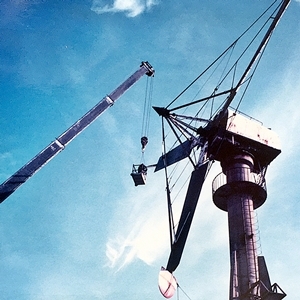
|
1993 - Juul's rotor is transferred to the Energy Museum
In 1993, the previous owner of Korsagervej 14 decided to install a newer Wincon Nacelle on Juul's concrete tower in Gedser.
Juul's rotor and nacelle were transferred to the Energy Museum in Jutland. Here, two blades (the third is stored) and nacelle were renovated and exhibited as one of the museum's popular attractions. According to the Energy Museum,
there were up to 3,000 screws in each blade made of aluminum sheets and wood. See the photo below from the Energy Museum.
|
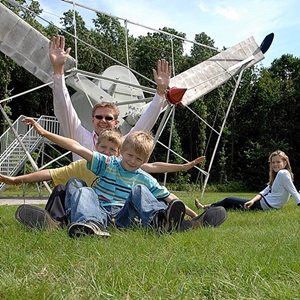
|
Photo: Energy Museum.
|
|
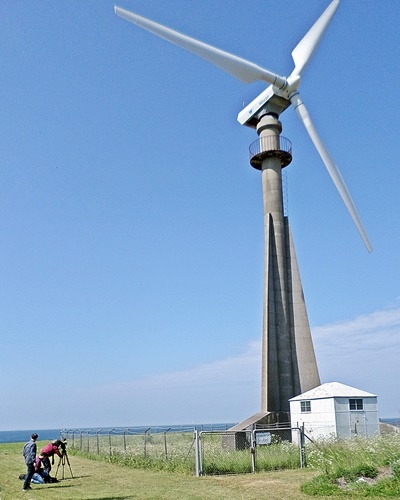
|
2016 - Offshore Symphony
Frank Pecquet and two students from the Sorbonne University, Paris, arrived June 2, 2016 in Gedser. Their ambition was to produce a web doc about the world-famous Eolienne de Gedser.
Standing so close to the old tower and hearing the whooshing sound from the rotating wings of the newer Wincon nacelle, the French musicologist
wondered: How may Gedser Wind Turbine have sounded?
And this inspired him to compose what is today a launch-ready Offshore Symphony.
In fact, Frank Pecquet was the first to propose a reconstruction of the Gedser Wind Turbine.
And yes, despite the Corona lockdown and other obstacles, he is still part of the project. Ready to implement Offshore Symphony with The Old Lady, which he chooses to call Juul's mill, as The Leading Voice.
The choir stands out in the sea in the form of the offshore wind farm and on land by the surrounding wind turbines.
.
|

|
2016 - Frank Pecquet
|
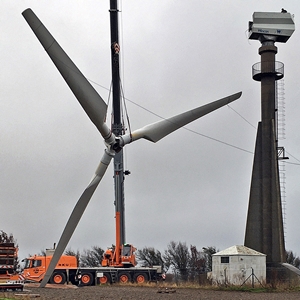
|
2019-20 - Removal of Wincon Nacelle
As a result of a settlement, the Wincon Nacelle is removed from Juul's tower on November 4, 2019.
On March 8, 2020, the Association: Operation of Gedser Wind Turbine is founded.
On March 11, 2020, the Danish Prime Minister Mette Frederiksen announces lockdown of Denmark due to Covid-19 pandemic.
On December 3, 2020, lawyer Jesper Popp issues a press release stating that the legal dispute between the lot owner Gitte Ahrenkiel and the lessee of the Wincon nacelle has finally been settled. This means that project Operation of Gedser Wind Turbine can be initiated.
|
Press release, December 3, 2020 by lawyer Jesper Poppp
(..) As the ownership of the tower has thus been decided, we find it is time to announce that the planned project on Reconstruction and Operation of Gedser Wind Turbine can now be resumed. This is done in already established collaborations with conservation authorities, museums and others.
The reconstruction project at Korsagervej 14 in Gedser, where the original historic tower is located, is administered by the Association: Operation of Gedser Wind Turbine, CVR: 41238992.
-Press release to the full extent, including photos

|

|
2022 - planned reconstruction of rotor incl. stays and colors
|
The Energy Museum maintains the exhibition of Juul's rotor and nacelle. Whereas the reconstruction project in
Gedser is fulfilling Juul's desire for turbine blades made of fiberglass. However, the characteristic stays and ropes are to be included in the recreated
rotor. Likewise the coloring of air brakes in red, blue and white as well as the red snout.
We are investigating the possibility of designing the blades in recycled fiberglass.
|
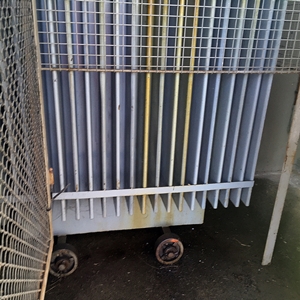
|
2022 - Applying for funding grants
We are currently applying for funding grants. Specifically to help cover expenses for either repair or replacement of oil-leaking transformer. If repair is not possible, our electricity network Cerius has offered to replace the oil-leaking transformer with
a renovated, fully operational transformer that in size and capacity fits Gedser Wind Turbine. Approximate price (incl. Crane): 100,000 DKK.
Covid-19 and the outbreak of war in Ukraine (Russian invasion February 24, 2022) have caused shortages of material supplies. Rising inflation also plays a role. Inflation impacts funds, individuals and businesses. This obviously affects the project.
September 2022 - the Danish LH Foundation has financed an internal anti-rust treatment of the transformer house.
Cat litter has been laid out to collect oil from the transformer.
- Click on the photo below.
|
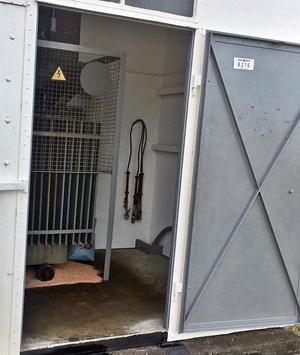
|
|